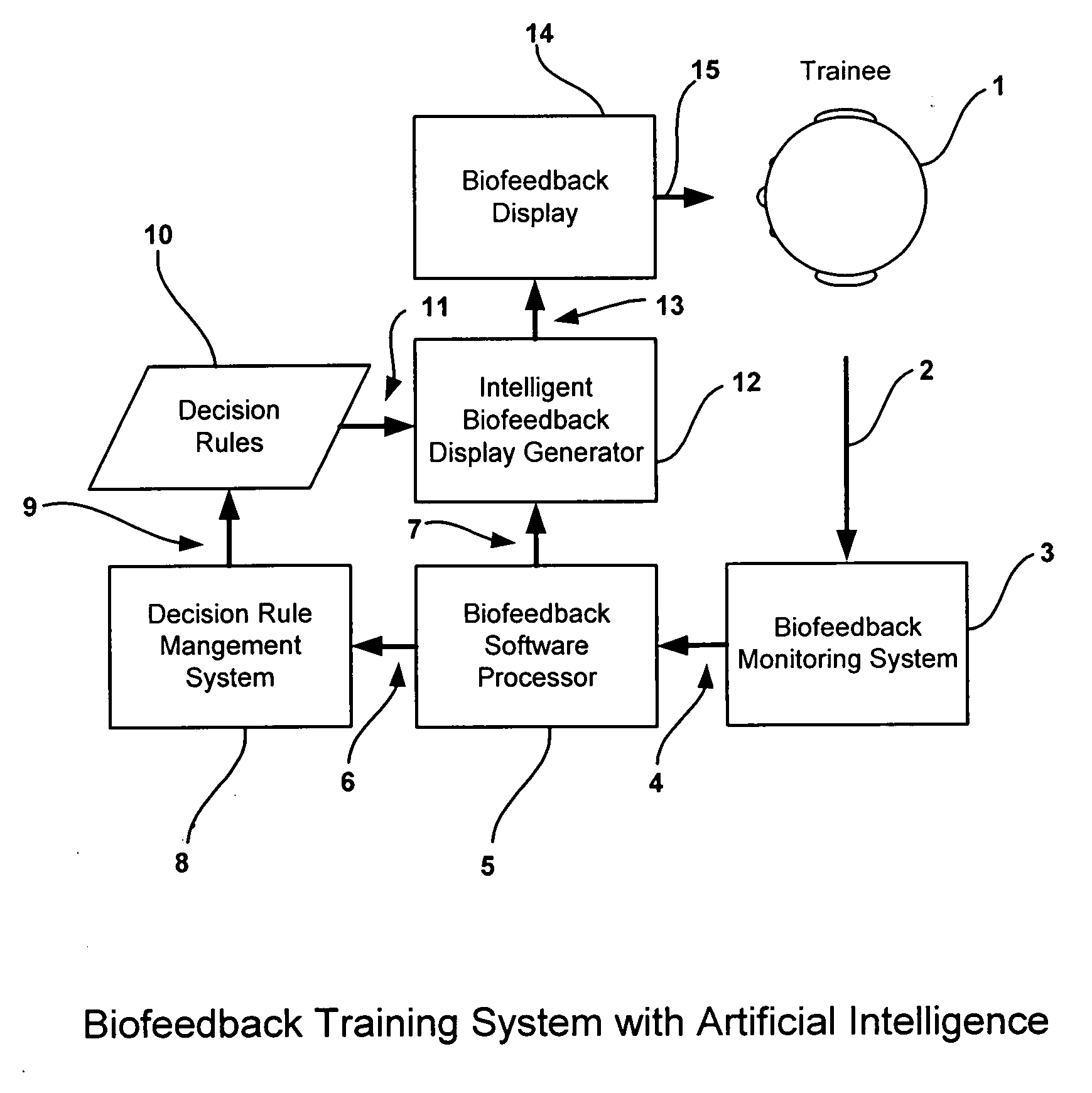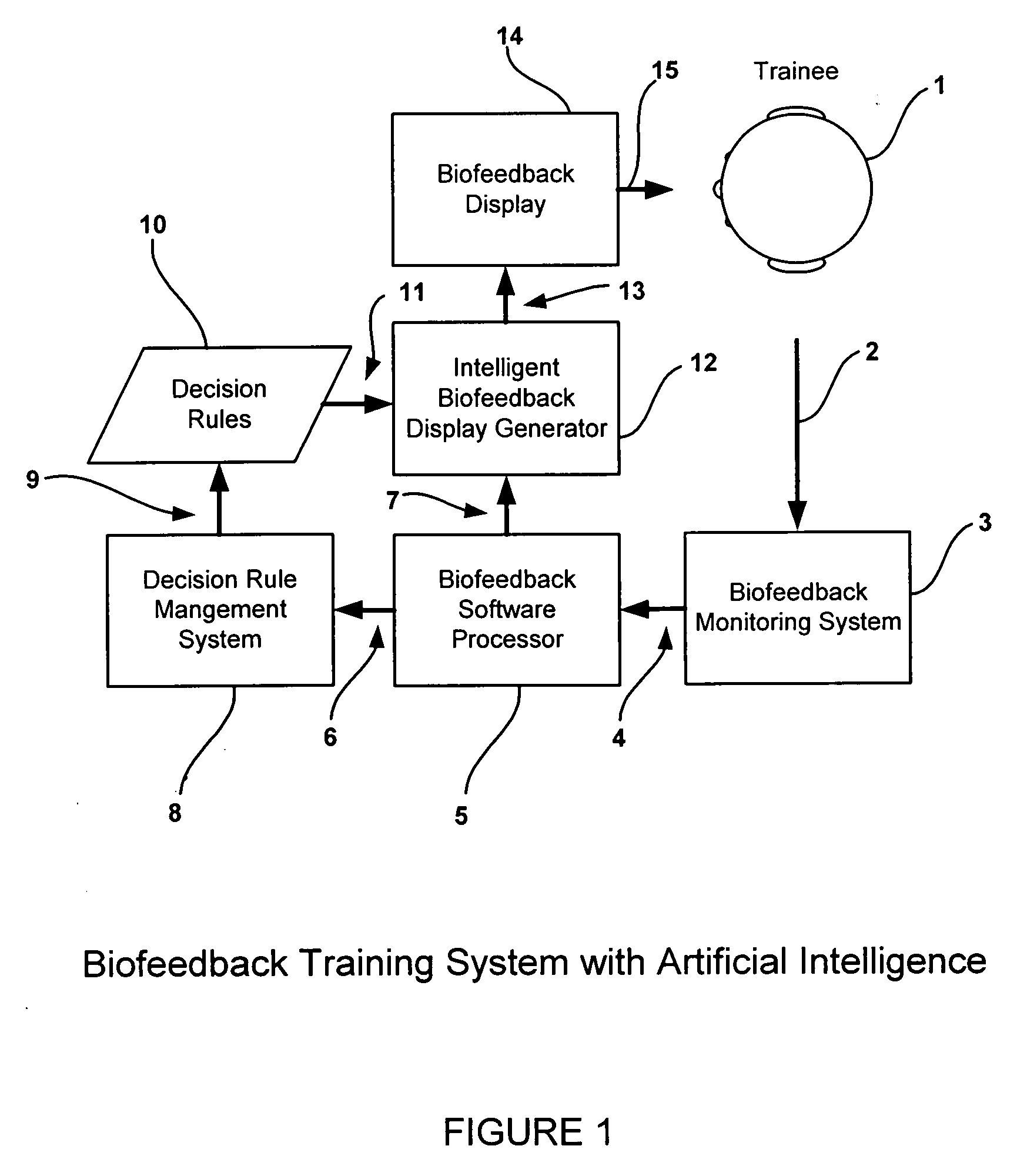[0005]In this invention, the feedback game is endowed with intelligence in the form of goal-seeking and decision-making behavior, providing an additional element of context, activity, and quality in the feedback. In this invention, the level of intelligence evident in the game is controlled (“modulated”) as an additional dimension of the training feedback, providing a deeper level of information and guidance.
[0007]In biofeedback and
neurofeedback, it is possible to modulate games that the trainee plays, as described for example in U.S. Pat. No. 6,450,820 to A. Pope et. al. Such interaction requires motor movements and attention, and can subvert the goal of the training, which may include stillness and relaxation, rather than activation. Such systems also may introduce
muscle and other artifacts, as a result of the required playing activities. Therefore, games that “play themselves” are of specific value in biofeedback and
neurofeedback, in providing an informative and engaging display, that nonetheless allows the trainee to influence the progress and success of the game display. The trainee watches the progress of the game, and watches the “player” move and act toward the goal of the game, without having to use keyboard or
joystick controls, for example, to control the game progress. In other words, the level of intelligence in the game is used as a biofeedback variable.
[0008]In this invention, the trainee does not have to interact with the game in any manner other than by producing the biological signals. This allows the trainee to remain still, and to focus their attention on the game, as the only means or method necessary to control the game, as well as to modulate the behavior of the game. If the game has perceptible hindrances or shortcomings, then these are in principle under the possible control of the trainee, who can influence the intelligence and efficiency evident in the game, by addressing their ability to make progress in the
biofeedback training.
[0009]Humans are able to perceive and interpret complex information such as high-level behavior of a
system, and to use that information in the pursuit of learning. Humans are also prone to become bored with repetitive or constant experience, and seek novelty and improvement. Such novelty and improvement constitute powerful rewards, and a
system that incorporates such novelty and improvement will benefit by providing additional interest, incentive, and information to the trainee. The result is the ability to perform the training with increased interest, with increased
perception and understanding, and for longer periods of time. An additional result is the ability to perceive qualitative changes (improvement or degradation) either within a session or across sessions, as an additional index of progress.
[0010]In this invention, the existence of decision-making rules and other abilities within the embedded
game player are introduced and controlled as additional types of feedback variables, in addition to the traditional “stop / go” or “faster / slower” modulation in the feedback. Such abilities would typically be controlled in a gradual fashion, so that abilities and capabilities appear and disappear as the game progresses, and represent additional rewards in the training progress. The achievement of a rule or ability constitutes a reward on its own, and in addition further facilitates progress and speed in the game, providing satisfaction and a sense of accomplishment, as well as a sense of power and ability on the part of the trainee. For example, in a maze type game, the following types of abilities may be introduced and modulated by the systems and methods of this invention:The ability to make an advantageous decision upon hitting a “wall”.The ability to see goals that lie in the existing path, and to stay on that path.The ability to “see” adjacent goals, and to change course to pursue them.The ability to “see” nearby goals, and to change course to pursue them.The ability to “know” where distant goals lie, and to change course to pursue them.The ability to “know” where and when special goals exist, and to pursue them.The ability to “know” where obstructions lie, and to avoid them.The ability to “know” where “enemies” lie, and to avoid them.The ability to predict the course of “enemies” and to avoid such routes.The ability to defend oneself against “enemies” by becoming immune to their effects.The ability to
restrict the movement of “enemies”, thus avoiding their effects.The ability to change course without having to hit a wall.The ability to change course in the absence of immediately “visible” rewards.The ability to change course based upon planning of the eventual
route.The ability to change course to avoid unnecessary long routes.The ability to change course to acquire nearby rewards first, to avoid roundabout routes.The ability to adjust the speed with which the agent runs the maze.The ability to travel at a faster speed.The ability to go faster when there are no goals being acquired, in order to seek distant goals more quickly.The ability to use
random choice, to provide variability in running the maze.These constitute examples of intelligence and abilities which can be incorporated into a maze type game in accordance with the principles and concepts of the invention.
[0013]As a result of this method, it is possible to construct gamelike biofeedback systems and displays that have one or more of the following representative properties:Provide a wide range of feedback performance, rather than a simply scaled variable.Provide qualitatively different feedback, depending on the trainee's progress.Provide intuitive visual indicators of the trainee's progress.Provide feedback in which the level of perceived intelligence in the game reflects the quality of the trainee's performance.Provide feedback in which the game “player” provides an analog of the trainee.Provide feedback in which the game “player's” evident intelligence and performance.Provide a representative of the internal state of the trainee.Provide feedback in the form of intelligence and empowerment, which reward the trainee.Provide the reward of seeing the game played differently, or better, as training progresses.Provide an element of novelty, as the rules and decision-making of the embedded agent change.Provide a fast
visual assessment of the trainee's progress by watching the game progress.Provide a fast
visual assessment of the trainee's state by viewing the current display.Incorporate assessment directly into the training system or method.
 Login to View More
Login to View More  Login to View More
Login to View More 


